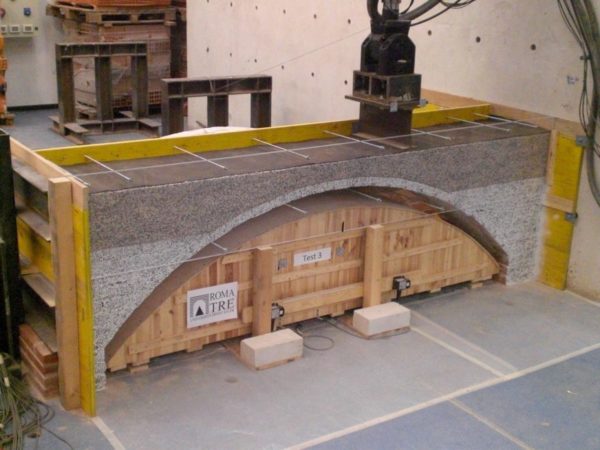Strengthening with advanced composites
Strengthening masonry vaults with SRG and TRM
Description
Masonry vaults can be particularly vulnerable against unsymmetrical service loads, support displacements and seismic actions. Therefore, retrofitting is often needed to ensure an adequate safety level according to current standard codes, and, for this purpose, externally bonded composites are emerging as a promising solution.
In order to investigate the gain in load-carrying capacity provided by externally bonded mortar-based composites bonded to masonry vauls, an experimental study was carried out in Roma Tre University on six full-scale vault specimens. One of them was tested unreinforced, whereas the other ones were strengthened with Steel Reinforced Grout (SRG), comprising ultra high tensile strength steel cords, or Textile Reinforced Mortar (TRM), comprising a bidirectional mesh of basalt fibers and stainless steel micro wires. A lime-based mortar was used to bond the fabrics either to the extrados or to the intrados of the vaul specimens. The vaults, provided with backfill and buttresses, were subjected to cyclic loading at 1/3 span. The backfill was visible through a panel of Plexiglas, allowing for the use of Digital Image Correlation to measure the displacement field and derive information on damage pattern and arch-fill interaction.
This study is carried out within a Research Project funded by the Italian Ministry for Foreign Affairs “Composites with inorganic matrix for sustainable strengthening of architectural heritage”. Web page of the Project.
Key publications on this topic
- De Santis S., Roscini F., de Felice G. Full-scale tests on masonry vaults strengthened with Steel Reinforced Grout. Composites Part B: Engineering 2018;141:20-36. DOI: 10.1016/j.compositesb.2017.12.023.
- De Santis S., Roscini F., de Felice G. Retrofitting masonry vaults with Basalt Textile Reinforced Mortar. Proc. Int. Conf. MuRiCo5 5th International Conference on mechanics of masonry structures strengthened with composite materials. Bologna, Italy, 28-30 June 2017. Key Engineering Materials 2017;747:250-257. DOI: 10.4028/www.scientific.net/KEM.747.250.
Photo & VIdeo Gallery
Test on the unreinforced vault specimen
Main features of the test
- Span of the arch: 2.8m
- Rise of the arch: 65cm
- Thickness of the arch: 5.5cm
- Width of the arch: 50cm
Main test results
- Maximum force attained in the test: 5.9kN
- Displacement corresponding to the peak load: mm
- DIsplacement at failure (end of the test): mm
- Failure mode: 4 hinge mechanism
Test on the vault specimen reinforced at the extrados with a steel textile
Main features of the test
- Unidirectional textile of galvanized Ultra High Tensile Strength Steel cords
- Width of the strip: 150mm
- Matrix: lime-based mortar
- Surface of application: extrados
Main test results
- Maximum force attained in the test: 15.9kN
- Displacement corresponding to the peak load: 22.8mm
- DIsplacement at failure (end of the test): 85.8mm
- Failure mode: detachment and sliding at the fabric-matrix interface, crushing of masonry
Test on the vault specimen reinforced at the extrados with a basalt fabric
Mean features of the test
- Bidirectional mesh of basalt fibres
- Width of the fabric: 500mm
- Matrix: lime-based mortar
- Surface of application: extrados
Main test results
- Maximum force attained in the test: 14.1kN
- Displacement corresponding to the peak load: 13.9mm
- DIsplacement at failure (end of the test): 67.5mm
- Failure tensile rupture of basalt fibres, crushing of masonry
